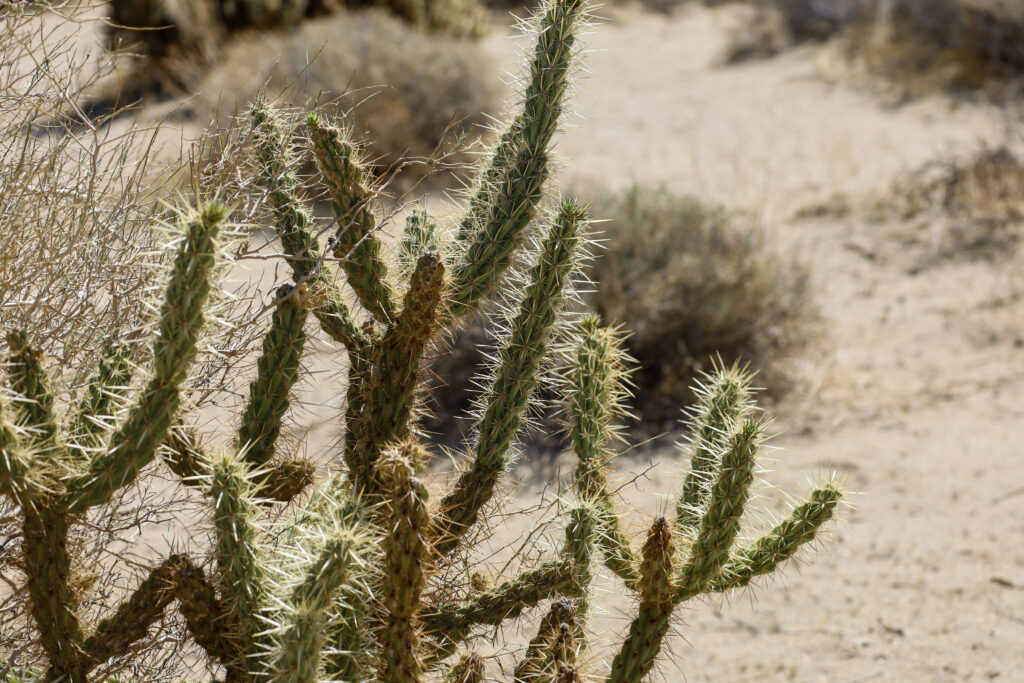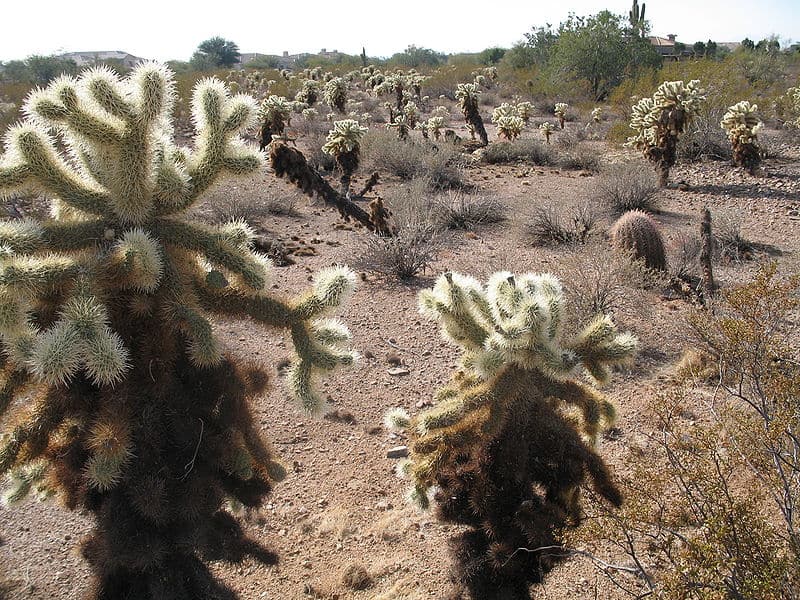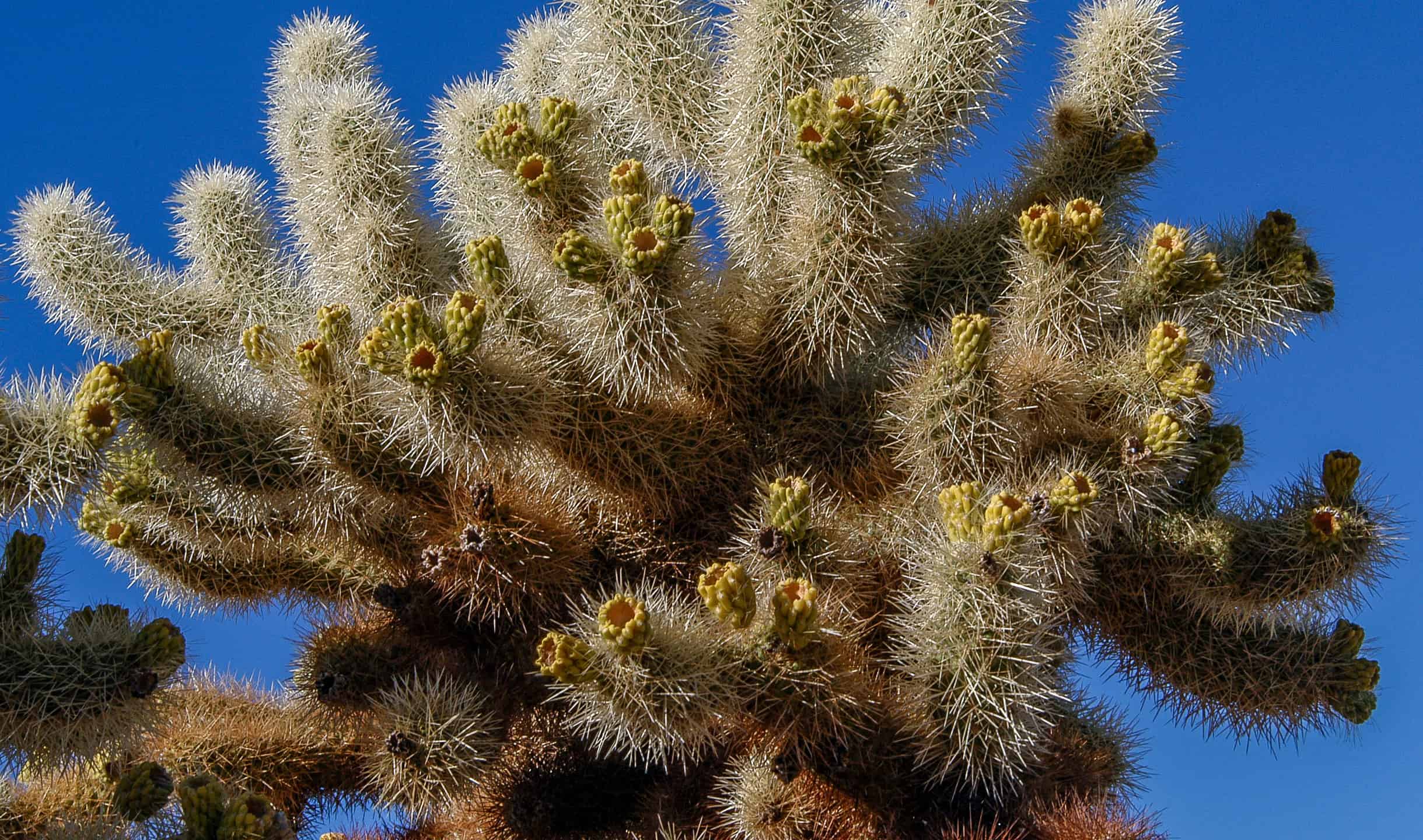The cholla cactus is a pretty incredible plant, though natives of Arizona are other parts of the Sonoran desert tend to not love it all that much. The plant possesses terrible spines that have a dreadful propensity to cling to human skin when brushed up against it. Desert hikers and gardeners alike know how much of a painful hindrance the cholla cactus can be!
The stinging barbs of this plant are encased in a sheath that resembles paper and can be rather colorful and appealing for landscaping. Although they do have some nasty barbs, the plant complements a southwest-inspired garden beautifully.
This species of cactus is unique in that it can take on many forms. It can be grown as a creeping plant, a shrub, or even as a tree. They can stay very small at just a few feet tall or tower over buildings at 15 feet in height.
It helps to have some knowledge of how to care for these plants appropriately if you’re thinking about growing your own cholla or transplanting some plants into your yard. To get you started, we’ll provide you with some knowledge on the jumping cholla and some pointers on how to grow cholla cactus plants in this guide. Just be careful around the plant and beware of those spines!

The California Cholla (pictured) is one of many species of cholla cacti.
©Rosamar/Shutterstock.com
What is a Cholla Cactus?
The term “cholla cactus” can refer to any member of the Cylindropuntia genus of cacti. However, the term is often used to refer to the jumping cactus. The cholla jumping cactus is a member of the Cylindropuntia genus and is classified as Cylindropuntia fulgida. It is also known as the jumping cholla or the hanging chain cholla cactus. Although this species is specifically referred to as a “jumping cholla,” the label is commonly used to refer to all chollas as a whole.
Cholla Cactus Anatomy
The cholla cactus resembles a tree and has a single low-branching trunk. It often reaches heights of 13 feet and has drooping branches covered in fruit chains. The stems are bright green and have little wart-like projections called tubercles that are roughly one inch long. The plants work together to create amazing-looking forests that can cover several acres.
This cactus has changed its anatomy over time, and now its leaves have evolved to become spines. Around one-inch-long, silvery-yellow spines that eventually become gray are seen on young branches. The stems are hidden by a thick coating of these spines. Older or slower-growing branches contain fewer or shorter spines. Older portions’ spines fall off, exposing the cholla’s brownish bark. As it ages, the plant tends to get scratchy and scaly.
Cholla cacti can develop into trees but are generally shrubby or groundcover cacti. These cacti have numerous joints separating their cylindrical stems and are heavily segmented. Their spines are notoriously unpleasant and painful if touched. Be careful if you go looking for these cacti!
Benefits of the Cholla Cactus
Species of sheep and some deer species, such as the white-tailed deer and mule deer, depend on the fruit of the cholla cactus for food and as a source of water during dry desert spells. Populations of this cactus are steady due to the fact that they thrive in difficult and inaccessible desert environments. Jumping chollas have also been observed to house cactus wren nests. To put it simply, this species is very beneficial to the ecosystem it grows within.
Cholla Cactus Native Environment
This species can be found growing at altitudes between 980 and 3,280 feet. Its hardiness zone is in zone eight and above.
Cholla cacti are some of the most prevalent cacti seen naturally growing in deserts in the southern United States and Mexico. The Sonoran Desert and the southwestern region of the United States are home to the cholla cactus. The whole state of Sonora, with the exception of the Sierra Madre Occidental cordillera in the east and northern California, is where the jumping cholla can be found in its maximum range.
The range of this cactus stretches into Arizona and California’s Colorado Desert in the southwestern region of the country. It can be found in a few specific locations in Arizona’s northwest-central Sonoran Desert, south and southwest of the Arizona transition zone of the Mogollon Rim. Just as well, its native range extends into the very southern region of the Great Basin Desert in southern Utah as well as the northeastern portion of the Mojave Desert in southern Nevada and Utah.

Cholla cacti (pictured) can grow across deserts and even along coasts.
©CoachRad/Shutterstock.com
Colors of the Cholla Cactus
The body of the cholla cactus, like most cacti, is green. Its hues can range from a deep emerald hue to a muted, grey-green or blue-green color. Older cacti or dying cacti tend to be a bit greyer with brown spots.
The flowers of the cholla cactus are white and pink in color with bits of purple or lavender hues. Some flowers of some varieties or other cholla species can be a vibrant fuchsia hue or even orange. These flowers are only about an inch wide and bloom at the old fruit tips of the plant. They tend to bloom in the summertime. They are unique in that they have a tendency to open at a very specific time during the day.
The cholla cactus also produces fruits. This fruit is usually green in hue with sparse yellowish spines. These fruits around only about an inch and a half long at maturity. The fruits tend to grow in long green chains, hence the name hanging chain cholla cactus. Flowers are eventually produced from these fruits.
When Will My Cholla Cactus Bloom?
When planted inside, cholla cacti seldom bloom. But when they do, blooms usually appear between April and mid-July. Depending on the species, the flowers can be cup-shaped and come in a variety of colors, although they usually have hues of white, yellow, orange, red, pink, or even green when first blooming.
How to Grow a Cholla Cactus
As cholla cacti are known for their hardiness, they will likely be content as long as you can give them a lot of sunlight. Although certain species can thrive in hardiness zones as low as zone five, they can be cultivated in USDA hardiness zones eight and above. When it comes to growing cholla, dampness should be avoided at all costs. These cacti can quickly become overwatered despite their strong drought tolerance, especially if they don’t have enough light.
Cholla cacti feature several long, sharp spines that are coated in tiny barbs; as a result, should one of these spines become trapped in your flesh, it will be highly painful and challenging to extract it. If you have dogs or young children at home, use caution while handling this plant, and make sure to store it in a secure area.

Cholla cacti (pictured) grow best in their native Sonoran Desert.
©Dominic assumed (based on copyright claims) / public domain – Original / License
Repotting and Transplanting a Cholla Cactus
Cholla cacti don’t require regular repotting because they can endure being a bit rootbound. Repotting your cholla cactus every two to three years should be sufficient, depending on their growth environment. Repotting should be done in the spring or summer when the plant is actively developing. You should pick a container that is only one to two inches bigger than the previous one.
Make sure you are wearing a heavy pair of protective gardening gloves to protect your hands from the cholla cactus’s sharp spines before you begin repotting it. To help you in removing the cactus from its pot, you might also wish to use some equipment like tongs or perhaps a sizable blanket or towel. Remove as much of the old soil as you can when repotting without harming the roots, then replace it with fresh soil.
Pruning a Cholla Cactus
When it comes to cholla cactus maintenance, pruning is not required, but you could decide to do it on occasion to manage your cactus’ size or improve its beauty. Before you begin trimming, make sure you are wearing a sturdy pair of protective gardening gloves. The cylindrical stems will readily split from one another into these areas, thus it is preferable to make incisions there.
Water Needs for a Cholla Cactus
Cholla cacti are very resistant to drought and do not require regular irrigation. Be careful when it comes to overwatering, which can kill chollas easily. Wait until the soil is totally dry in between waterings.
Soil and Fertilizer Needs for a Cholla Cactus
Because of their extreme susceptibility to root rot, these cacti require soil that is both dry and well-draining. The optimum soil for these desert inhabitants is sandy soil. For growing cholla cacti inside, use a cactus or succulent soil blend or add plenty of sand to regular potting soil to improve drainage.
Cholla cacti don’t consume a lot of food and don’t require regular fertilization. If desired, a fertilizer made for cacti and succulents can be used once a month from the beginning of spring to the end of summer, although it is not required.
Sunlight Conditions for a Cholla Cactus
Cholla cacti require a lot of direct sunshine to survive. A place with approximately six to seven hours of direct sunlight each day is ideal. Cholla cacti can be grown indoors, but they thrive best outside where they can receive unfiltered sunshine because of how much light they require. Simply make sure the sun is directly shining on the cholla cactus and that it is in a west or south-facing window.
Temperature and Humidity Needs for a Cholla Cactus
Cholla cacti thrive in warm, dry environments. In fact, the Cylindropuntia genus is one of the Cactaceae family’s most heat-tolerant genera of cacti. Yet if necessary, certain cholla cultivars can also endure extremely low temperatures of as low as -5 degrees F. That’s one heck of a resilient cactus! Although these cacti actually do best in warm climates, it is still advisable to avoid such drastic cold exposure if at all possible.
Pests to Watch Out For
When it comes to common pests and diseases, cholla cacti generally have few adversaries. Yet, if they are grown in constantly damp soil, they are extremely prone to root rot. Watch out for mealybugs as well, which can occasionally penetrate the cacti’s prickly skin and settle against their fleshy stems. Simply spray the cactus with rubbing alcohol or an organic pesticide if you see any evidence of mealybugs. You should also move the plant out of the sun before spraying it, and don’t put it back until it has completely dried.

Mealybugs are known for targeting cacti (pictured) and need to be dealt with quickly to avoid plant death.
©panattar/Shutterstock.com
Diseases and Illnesses to Watch Out For
As we mentioned in the above section, cholla cacti are resilient and rarely have issues. Any problems you observe with your cactus are typically a sign of either incorrect irrigation, a temperature problem, or pest infestation.
A cholla cactus with mushy stems is not a good sign and typically indicates that the plant has root rot. To prevent the rot from spreading throughout the entire plant, immediate treatment is necessary. Make a quick cut to the stem above the area of rot using a pair of pruning shears or scissors. The remainder of your cholla plant should then be rooted in new soil by following the propagation stems.
Shriveled stems can also be a problem. Shriveled stems usually indicate underwatering. While this cactus can tolerate drought, it occasionally needs water. You should try to propagate a stem from your cactus in order to rescue it if it doesn’t revivify after a decent watering since the roots themselves may have dried up from the lack of water.
While drooping stems might signal a few different things, they eventually point to an issue with the cacti’s habitat. Drooping stems can be caused by temperature shock, a lack of water, or a mealybug infestation. If you suspect temperature stress is the cause, you should try to salvage the plant by propagating any of the remaining healthy stems. Some cacti don’t recover well from temperature shock.
Is It Hard to Grow a Cholla Cactus?
As cholla cacti are known for their hardiness, they will likely be content as long as you can give them a lot of sunlight. When it comes to cultivating cholla, dampness should be avoided at all costs. This cactus should not be planted in an area with a lot of humidity or rainfall.
When it comes down to it, leaving your cholla cactus alone is the best thing you can do for them. As we mentioned earlier, you do not need to water them regularly because they are quite tolerant of drought. Overwatering can lead to root rot, which might harm your cactus permanently. But if you can leave it alone, this cactus will live for a very long time. Particularly if it is planted in its natural environment, it can survive for decades.
It is important to remember that cholla cacti will readily attach to flesh, fur, and hair. While not poisonous or deadly in any sense, their spines can be uncomfortable to touch and even painful to remove. Ensure sure that they are grown away from inquisitive creatures like cats, dogs, and especially kids. If you wish to grow this type of cactus, you need to consider its pain-inducing tendencies carefully. It shouldn’t be a problem if it is planted out of the way of walkways.
What’s not to love about this absolutely stunning plant? Cholla cacti can be a bit dangerous in the sense that their spines can cling to your skin and cause a lot of pain. However, if kept out of reach and away from walking paths, these lovely specimens of the Sonoran desert can complement any desert garden project.
Thank you for reading! Have some feedback for us? Contact the AZ Animals editorial team.








